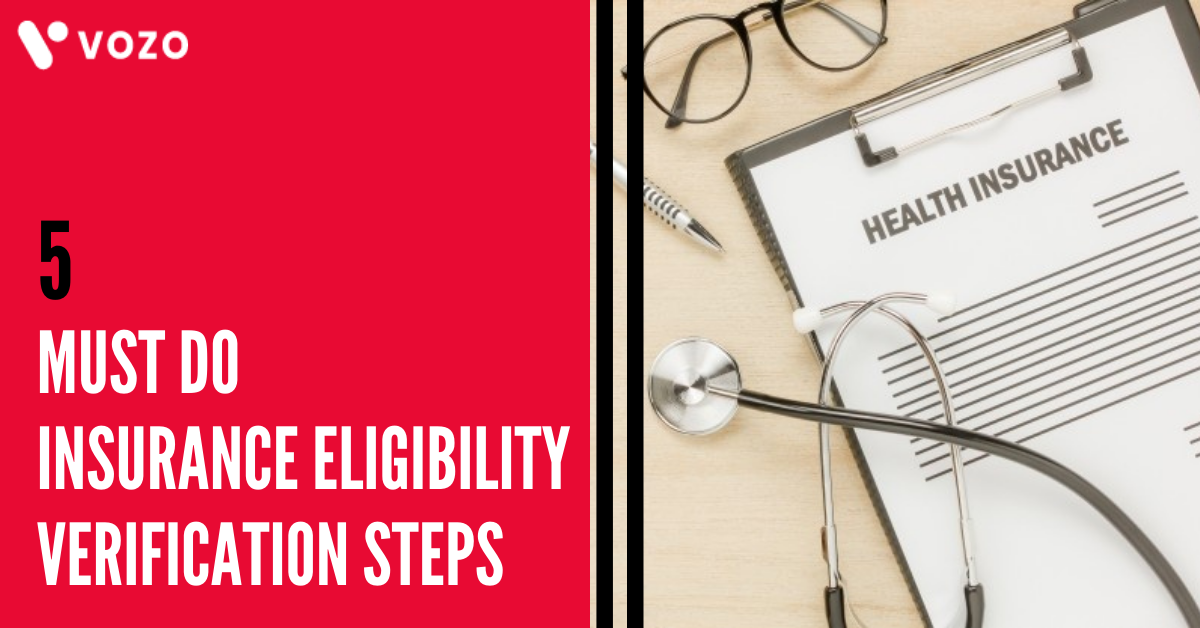5 Must Do Insurance Eligibility Verification Steps
According to the Centers for Medicare & Medicaid Services (CMS), two-thirds of healthcare practice revenue is lost due to billing leak, and 30% of claims being denied or rejected on the first submission. So an accurate insurance eligibility verification process plays a major role in improving practice workflow. In this article, we discussed the five most important insurance eligibility verification steps you should never miss.
Insurance Eligibility Verification Steps
1. Create A Complete Checklist For Insurance Verification
During the insurance eligibility verification process, each piece of information should be valid and correctly noted. The respective staff should enter information gleaned from the insurance card, phone calls with the insurance company, or electronic eligibility systems. Insurance eligibility verification information in each patient’s electronic medical record for your practice should include the following details
- Insurance name, phone number, and claims address
- Insurance ID and group number
- Name of insured, as it isn’t always the patient
- Relationship of the insured to the patient
- Date of policy (both effective and end date)
- Coverage status (whether active or inactive)
- Whether the insurance covers the procedure, diagnosis, or services to be provided
- The amount of the patient’s copay and deductible
- Whether your practice participates with the plan
- Limitations of the policy, including exclusions or documentation requirements for bills
- Whether a referral, pre-authorization certificate of medical necessity is required for payment
2. Patient’s Insurance Card Is Must For The Process
Begin the process of collecting insurance eligibility verification information by asking for a copy of new insurance information from the patient. It’s a good idea to ask for a copy of the card even if the patient states that insurance hasn’t changed. An updated image of both sides of the insurance card in your electronic health record provides an informational backup in case someone mistyped insurance information into the record. Medical billers should double-check ID numbers against cards before sending claims.
3. Contact The Insurance Provider Directly
Don’t take information on cards at face value. Even a few weeks after a card is issued, insurance coverage may have changed or been discontinued. Contact the insurance company directly to ensure eligibility. Place a phone call using the provider hotline provided by the payer or use your integrated EMR and Billing System to ping larger payers such as Medicaid, and Medicare for eligibility data.
When you can set up electronic eligibility systems for payers, this is the most efficient option. You may be able to import data directly into electronic medical record systems, making the process even faster and avoiding possible data-entry errors.
4. Record Accurate Information To Eliminate Data Errors
Train office staff to take extra care when transcribing information into the patient record. The information builds the foundation of the medical claim, and a single transposed number can mean the difference between a clean claim and a denial. Rushing through insurance verification practices and making data errors may cause days or weeks of delay on payments, or the claim could go completely unpaid, which is bad for any medical practice.
5. Follow Up With Patient For Any Kind Of Information
If there are any questions or concerns, follow up with the patient about insurance information. Using a patient portal to inform patients of eligibility through email or online communication is efficient, but office staff can also phone the patient to let them know about co-pays or other issues. Informing the patient as early as possible about out-of-pocket expenses increases the chance you’ll collect those funds.
Final Thoughts
A complete insurance eligibility verification process will reduce the administrative efforts and time they spend on several websites to verify eligibility information, which ultimately decreases the claim denials.
Are you looking to collaborate with an expert team to relieve you from the insurance eligibility verification tasks?
By providing the best RCM solutions, Vozo improves your entire revenue cycle management more efficiently and avoid claim resubmission, claim rejections, and increase upfront collection through clean claims with the best insurance eligibility verification services.
About the author

With more than 4 years of experience in the dynamic healthcare technology landscape, Sid specializes in crafting compelling content on topics including EHR/EMR, patient portals, healthcare automation, remote patient monitoring, and health information exchange. His expertise lies in translating cutting-edge innovations and intricate topics into engaging narratives that resonate with diverse audiences.













